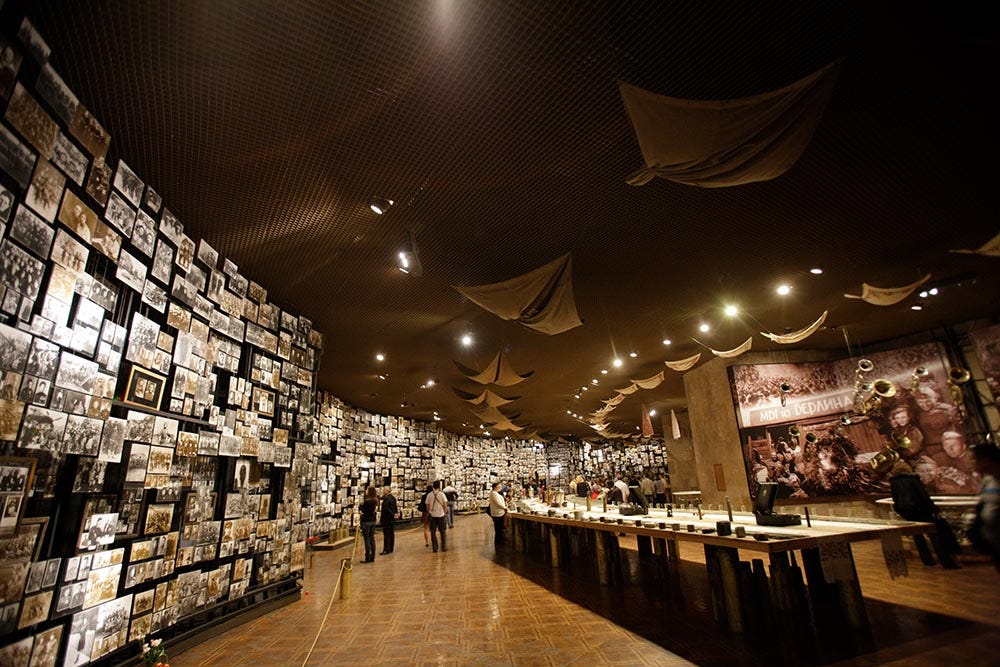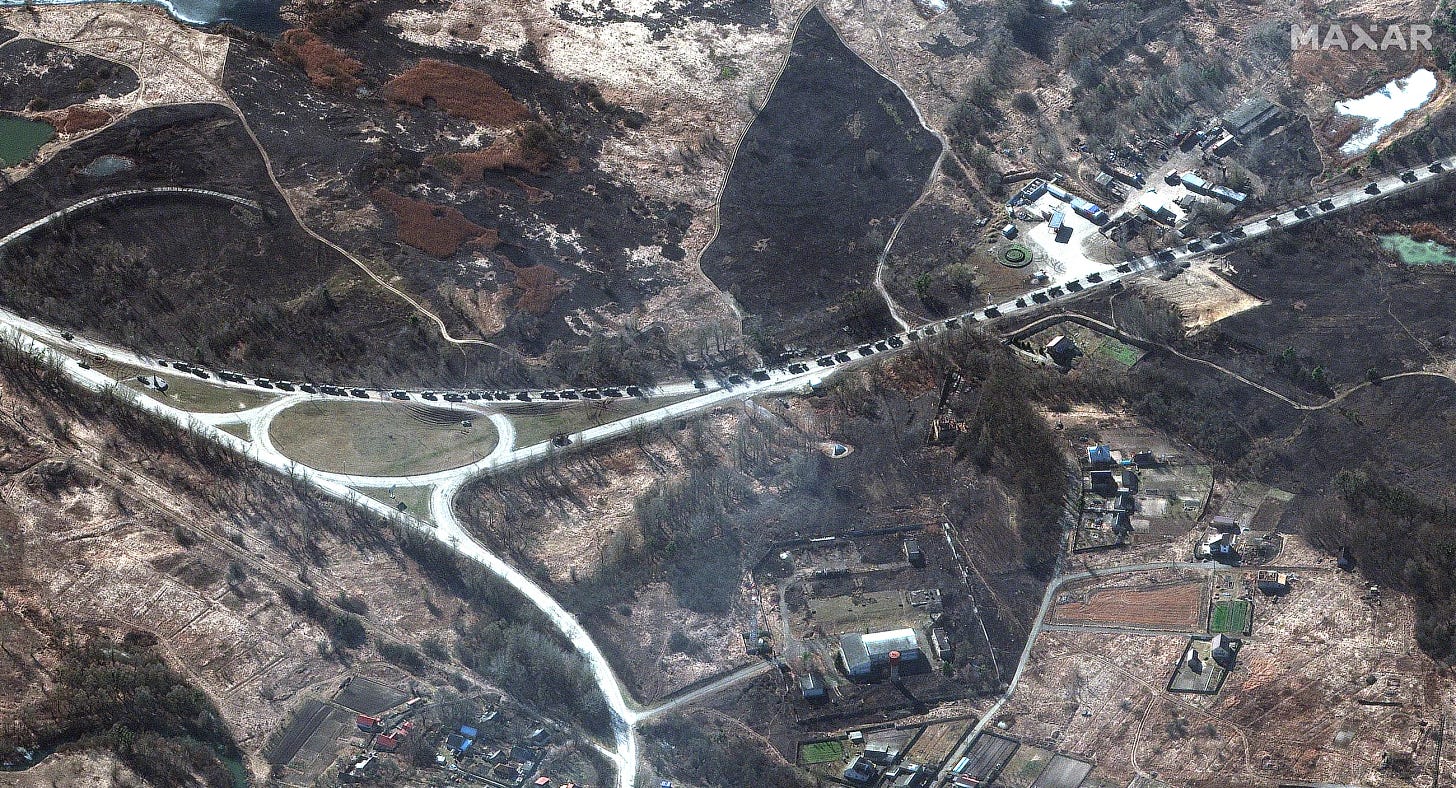Edited by David Swanson

In the National Museum of the History of Ukraine in the Second World War, at the very end of a sprawling complex of sixteen exhibit halls, there is a final room, the last stop. It’s called the Hall of Remembrance, and there is no sound in the chamber but the rasp of scarves or the thump of visitors’ thick winter boots. When you enter the Hall, there is a welded tangle of bugles affixed to a wall, and, behind them, a mural devoted to all the pomp of victory, images of the storming of Berlin, the defeat of Germany in what many post-Soviet states still call the Great Patriotic War. But the bugles are silent: the rest of the room is dedicated to the price of that victory. A long, long table spans the massive room, set for a feast. In lieu of plates, there are death certificates; the walls are lined with six thousand photographs of the war dead. It is, as the museum notes on its website, “a symbolic funeral table”—echoing the Ukrainian tradition of feasting in memory of the dead—but there are no chairs; there is no drink; no laughter and no music; just six thousand dead, and their empty cups.
Eighty-one years have passed since that war, but the glasses of the dead never fill, and the theater of war shuffles through its players with appalling speed. Kyiv is one of only twelve cities in the entirety of the former Soviet Union that attained the distinction of “Hero City,” claiming a civic Order of Lenin, the Soviet Union’s highest honor. The price of that honor is blood: a soul for every inch of the city, enough blood to merit distinction even in a war that drenched Europe in blood, the Soviet Union in particular. Three-quarters of a million people, soldiers and civilians, died before Kiev was taken, the vast majority of the losses Soviet; the city was entirely encircled by German forces. Three days after the Nazis took the city they shot thirty-three thousand Jews in a natural basin within the city limits known as Babi Yar, and forced Soviet prisoners of war to cover the bodies with the black earth. (Note: shortly before the publication of this post, a Russian air strike directly hit the Babi Yar memorial.)
The Sword and the Sandwich is a newsletter about deadly serious extremism and equally serious sandwiches. Please consider supporting this work with a paid subscription:
The Battle of Kiev in 1941 (I use the Russian transliteration deliberately here, as it was then capital of the Ukrainian Soviet Socialist Republic) was among the first major clashes of Hitler’s push to the East, the astonishingly profligate destruction of life known as Operation Barbarossa. Kiev was deliberately taken before the Nazi attack on Moscow, despite the Russian capital’s infinitely greater symbolic value. This is because Ukraine was the principal target of Hitler’s acquisitive eastward march, the imagined lodestar of his land empire: by accident of geology, Ukraine’s black earth, its chernozem, astonishingly fertile and luridly green in spring, has made it the bloody plaything of empire after empire. As the historian Timothy Snyder documented in his book Bloodlands: Europe Between Hitler and Stalin, “the forward motion of the Wehrmacht would be a journey backward in time.” Ukraine was the keystone of Hitler’s maniacal Hunger Plan, in which the Slavic population of Ukraine would be driven from the land and starved to death in order to feed the racially superior Germany and the rest of the territories it carved from Western Europe.
Of course, less than a decade earlier, Stalin had undertaken quite a similar initiative, if for different reasons: seeking to demonstrate the perfection of his enforced regime of collective agriculture, and then simply to take revenge on what he perceived as Ukrainian peasant sabotage, Moscow-directed grain requisitions forced the most fertile country in Europe into an entirely artificial famine, known in Ukraine as Holodomor (hunger-death). Up to ten million people died, the bread stolen from their mouths, cattle stolen from their byres, the whole country raided like a larder to feed the staggering hubris of empire. And then raided again, by another empire. And now: again, in 2022. Troops encircle Kyiv today as they did eighty years ago, another incursion by another tyrant, more blood soaking the black earth. This time the tyrant says he is trying to “denazify” Ukraine by killing its Jewish president; he is bombing Russian speakers in Russian-speaking cities so that, he says, they will be free to speak Russian. From inside the city, does it matter what alphabet is written on the sides of the tanks? You’re hiding anyway, dying anyway, digging anti-tank ditches like they did in 1941.
Ukraine is a large country, particularly by European standards: it is roughly the size of Texas, stands between East and West and on the Black Sea to its South; it served as the corridor of conquest for every invading force bound for Europe from the East (Huns, Bulgars, Mongols) or for Russia from the West (Poles, Austrians, Nazis, even the Swedish empire in the 1600s.) And as a result of this happenstance of geography, Ukraine was battered by every ideological gale and gust of the twentieth century with particular ferocity. Its nationalist movement contributed to a roiling civil war in 1917-21; its modernist art and literature was sparkling, dark and lush; its man-made famine a colossal example of the folly of imperialism; its struggle against fascism desperate; its Communism ardent, as it produced three Soviet supreme leaders; its disaster at Chernobyl a worldwide symbol for the dangers of nuclear power; and, in the waning years of the century, its declaration of independence perhaps the single most important blow against the Cold War world order.
But the twentieth century ended twenty-two years ago—we thought. In some sense, this hot war in Europe, this daylight invasion driven by an autocrat’s ideological zeal, this imminent threat of nuclear war—it feels like something from that terrible century, and not this century, which has had two decades to practice being absolutely terrible in entirely different ways. The Odessan poet Lyudmila Khersonskaya put it like this, before the current siege:
“Do you say there won’t be a war? I say nothing.
A small gray person cancels
this twenty first century,
adjusts his country’s clocks
for the winter war.”
Kyiv, having seen so much death, is a city of memorials: surrounding the World War II Museum, there is a spectacularly Soviet memorial complex. To approach the museum, you must walk under a great concrete arch carved with a star, on which is written, in metal: “Their feats will live forever, their names are undying”; lining the tunnel are statues and bas-reliefs of heroic soldiers and laborers, a triumph of socialist realism in metal. And over the entirety of this presides the Motherland Monument, a two-hundred-foot woman holding a sword aloft, erected of stainless steel in 1981; she overlooks half the city, and she holds her shield up, and she never gets tired.

Downhill, there is the Holodomor memorial—more recent, and post-Soviet, a belated acknowledgement: in Russian and Ukrainian culture, cranes symbolize the war dead thanks to a very famous Soviet ballad, and a wedge of beaten-gold cranes flies over the Kyiv skyline for those who died of hunger. A stone’s throw from these bright birds is an older and stranger memorial: the Pecherska Lavra, or Monastery of the Caves, created in the 1100s and one of the holiest sites in Eastern Orthodox Christianity. Its cathedral was destroyed during World War II, though whether this was done by the Nazis or the Soviets is still disputed; now, rebuilt, gold domes high on its elevated perch, it shines over the Dnieper River. Below it, honeycombing Mount Berestov, are the caves: visiting, you must descend with only a candle in your hand, and in niches in the endless caverns are the sainted dead in coffins of glass, brightly shrouded for their thousand years of holy internment down in the stone darkness.
How much memory does a city need? How many sacred dead, how many martyrs with undying deeds, how much bravery, how much blood? Suffering hollows out a person, hollows out a people, leaves room for little more than suffering.
The troops are gathering around Kyiv again, encircling again, with lethal intent, seeking to erase all that has happened in this twenty-first century, turn back the clock and split the atom all over again. For all the hoopla and the bloodlust and the money and the baying of the pan-Western war machine—which is tiresome and frightening and profitable and never satisfied—there are people dying in Kyiv, people in their apartments, people throwing Molotov cocktails at tanks, people demining bridges with bare hands, people that shouldn’t be dying this way. They’re dying in Odessa and Mariupol and Vasylkiv, dying in Vynnitsia, in Chernihiv, in Luhansk, dying in places that have seen enough violent death to soak the earth through a hundred times over. And they are fighting, as their parents did, and their grandparents, all for a tyrant’s whim.
A video from Kharkiv: a woman and a child stand in front of their burning house, and they say, heavy with sarcasm: “Thank you, Vlad, we’ve been waiting for you, this is just what we wanted.” This is a war that shouldn’t be; no man should be able to cancel the twenty-first century. No man should be able to send so many people to die pitted against one another in the cold, and make holy martyrs where men and women should be. Enough cranes have taken flight from this city to blot out the sky, which is so often clouded in Kyiv in wintertime, so often heavy with snow. There are enough empty cups at the funeral feast. Too many. One more would be too many. The Donetsk-born poet Iya Kiva put it like this in her poem The Year of Ukraine:
we were here you’ll say no we haven’t been here
someone else was killed by sniper fire here
and snow nailed those who came after to earth
the lord’s summer has gone it wasn’t enough







Thank you as ever Talia